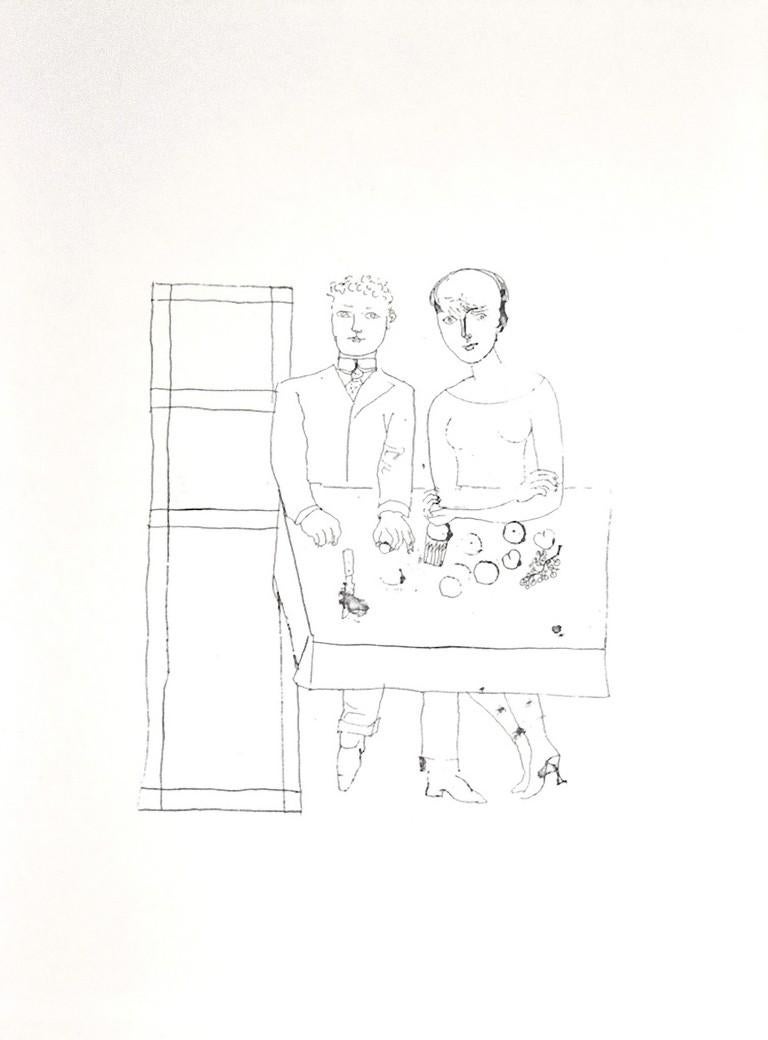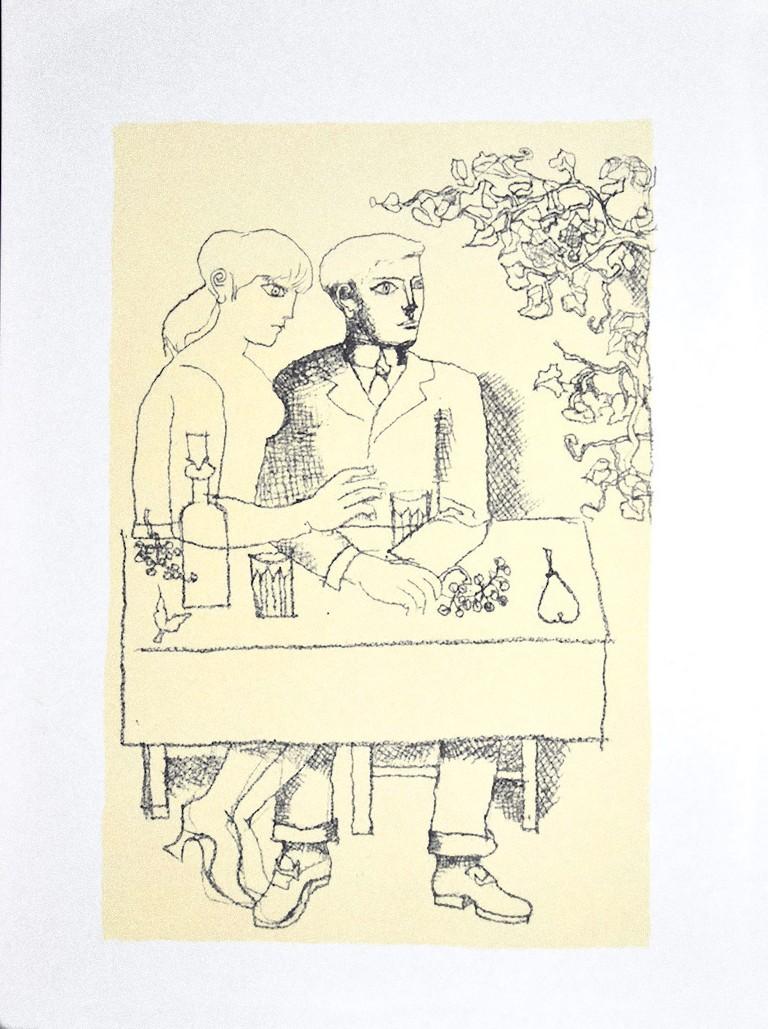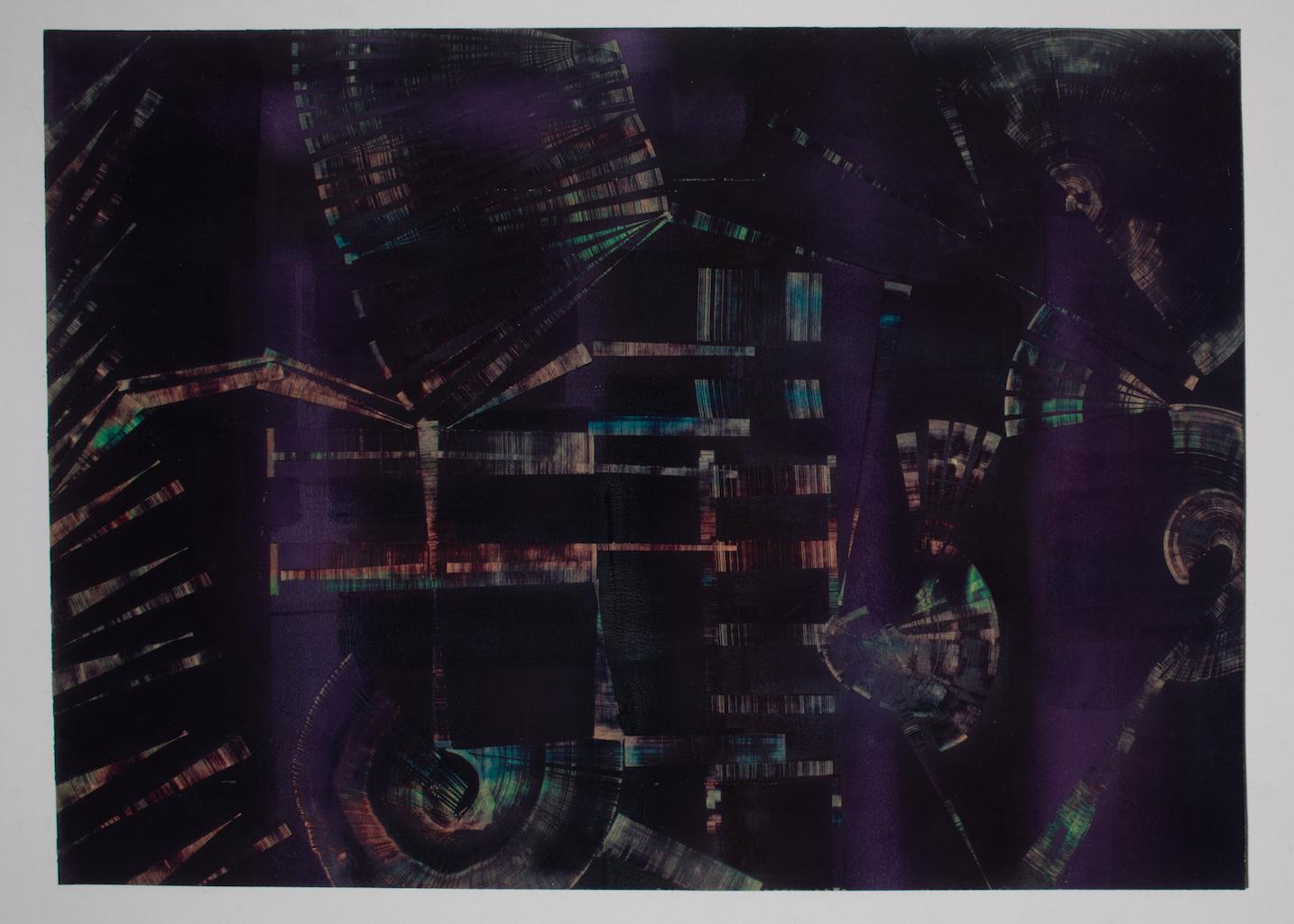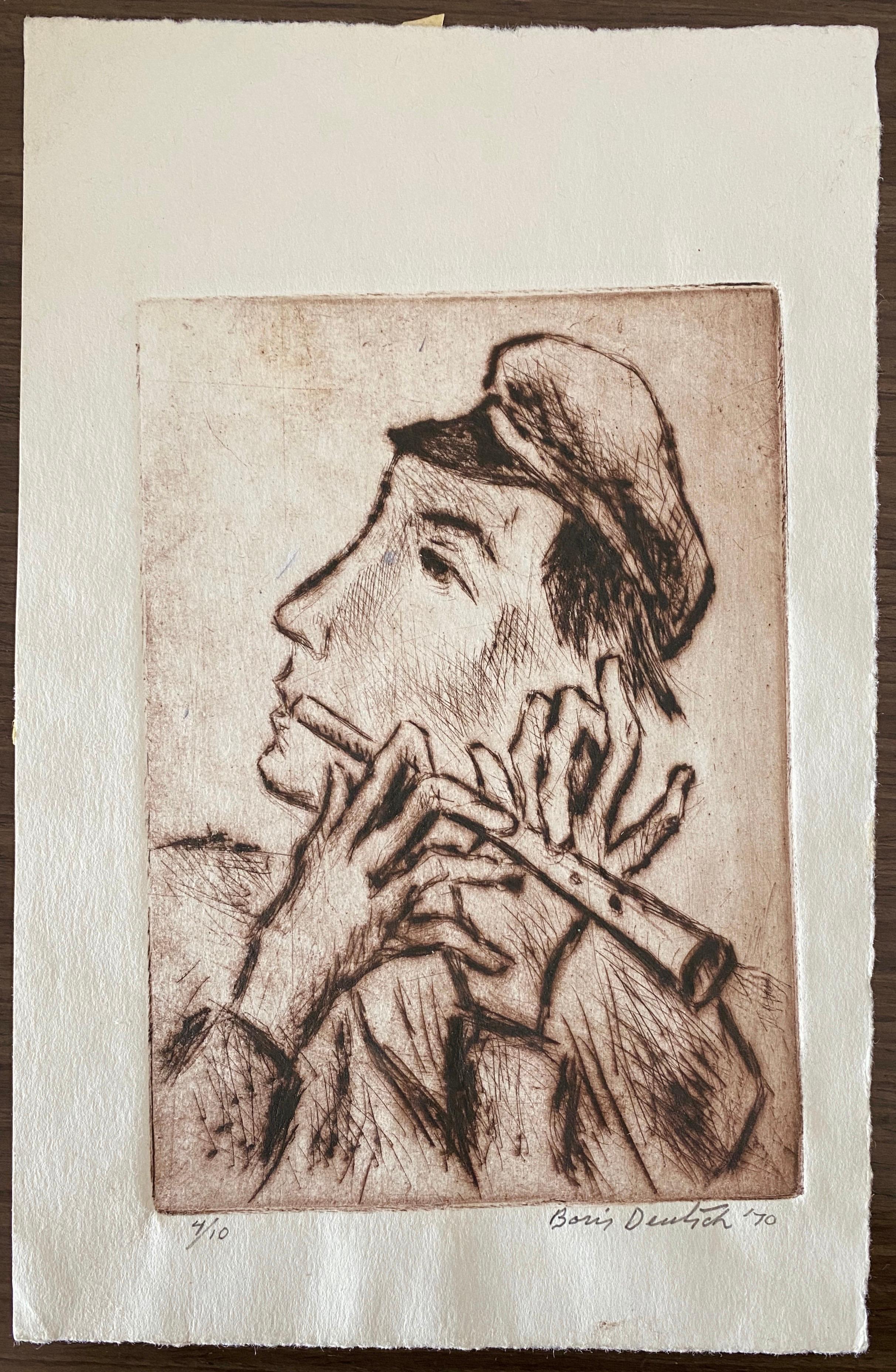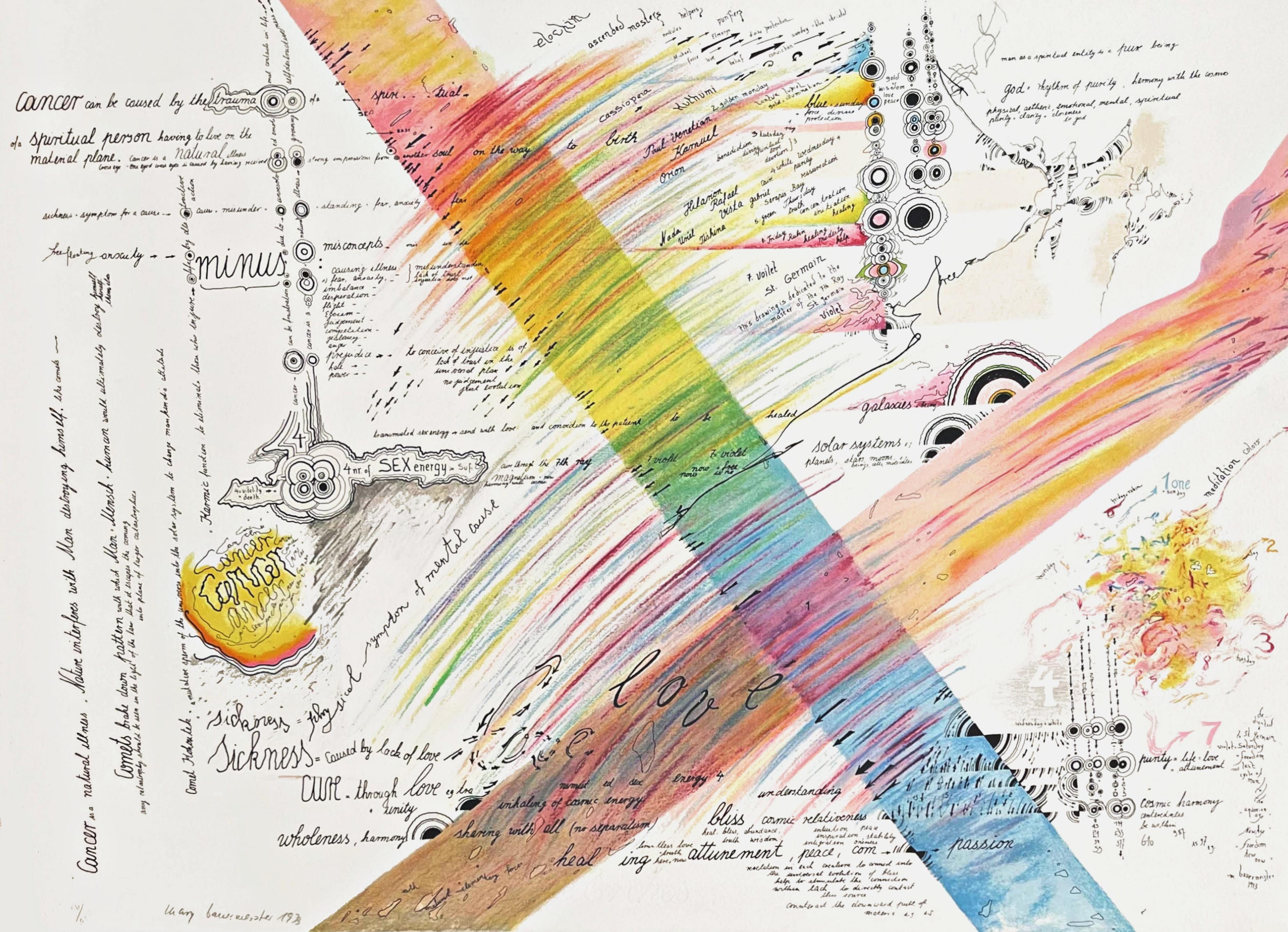Items Similar to Cafe Life
Want more images or videos?
Request additional images or videos from the seller
Michael BowenCafe Life1982
1982
About the Item
This artwork titled "Cafe Life" 1982 is a offset lithograph with a color crayon and oil pastel drawing on wove paper by American artist Michael Bowen, 1937-2009. It is hand signed and inscribed "Image" in color crayon. The image size is 27. 75 x 18 inches, the drawing is 9.25 x 7.25 inches, sheet size is 30.75 x 21.75 inches. It is in excellent condition, has never been framed.
About the subject:
Nowhere is the intertwining of metaphysical, biographic and social narratives more evident than in the Café Life series painted in the 1980’s. Though the “series” was done in the 80’s, the pieces really revive the spirit of the Beat café scene, which began in the mid-1950’s and which was so instrumental to the particular spiritual and social vibe of the counter culture. And his Café Life observations continue over his artist life with scenes, such as the ones here, from Los Angles, Bolinas, Mexico and Italy.
About the artist:
Michael Bowen (December 8, 1937 – March 7, 2009) was an American fine artist known as one of the co-founders of the late 20th and 21st century Visionary art movements. His works include paintings on canvas and paper, 92 intaglio etchings based on Jungian psychology, assemblage, bronze sculpture, collage, and handmade art books. An icon of the American Beat Generation and the 1960s counterculture, Bowen is also known for his role in inspiring and organizing the first Human Be-In in San Francisco. Chronicled in books and periodicals reflecting on the turbulent 1960s, Bowen's historical impact on both the literary and visual art worlds is well documented. He remains influential among avant-garde art circles around the world. He started his art career at age 17, when he joined the American installation artist Ed Kienholz in his Los Angeles studio. There he met and joined with other influential Beat Generation artists including Wallace Berman, John Altoon, and Dennis Hopper. Bowen participated in the construction of the Ferus Gallery and Now Gallery created by Ed Kienholz and curated by Walter Hopps. Bowen attended the Chouinard Art Institute for several years during his formative artistic experiences in Los Angeles. In the late 50s and early 60s, Bowen continued his spiritual training and research. He investigated and practiced a variety of occult topics, Eastern philosophies, and mysticism, and his artwork reflected these themes. Bowen is often referred to as a mystic artist. As a lifelong student of the Bhagavad-Gita, Bowen's entire career has emulated the spiritual warrior archetype of Arjuna, fighting for the Bill of Rights of the United States Constitution. Michael Bowen moved to San Francisco in the late 1950s, and along with fellow artist comrades Arthur Monroe and Michael McCracken, lived and worked out of 72 Commercial Street. Painting spontaneous, impromptu, hectic canvases, along with assemblage and collage, Bowen became an integral part of the San Francisco Renaissance. The Norwegian art patron and physician Reidar Wennesland befriended Bowen and many of his bohemian artist friends and collected their artwork. Bowen's work now makes up the majority of the paintings in the Wennesland Foundation Collection located in Kristiansand, Norway, alongside many other important North Beach artists, such as Jay DeFeo. A 1963 painting of Janis Joplin by Bowen, along with his prophetic 1966 Love painting, are examples of the Bowen works in the Wennesland collection. His style progressed from large abstract expressionist canvases to figuratives and large faces, to assemblage. Bowen's painting about McCarthyism, Red Future? from the Wennesland Collection, was featured in the 1995 Whitney Museum exhibition Beat Culture and the New America, 1950-1965, which opened in New York City, and then traveled to the Walker Art Center in Minneapolis and the De Young Museum in San Francisco, California. Exile from San Francisco In 1963, police brutality and persecution drove many of the Beat Generation writers, musicians, and artists out of San Francisco. Michael Bowen, along with many of his artist friends moved to an old Abalone Factory in Princeton by the Sea, where they lived and painted for many months. Bowen's singer friend, Janis Joplin was a frequent guest at the Princeton Abalone studio. In 1963, on one of Bowen's visits to be with his mentor in Tepoztlan, he was initiated into an ancient Aztec shamanic ceremony that inspired his future work with world consciousness transformation. After his initiation, Bowen traveled to New York City, where he established a studio in the Lower East Side and met with many of the Beat Generation artists, writers, and musicians living on America's East Coast. He often visited the two former Harvard professors Timothy Leary and Ram Dass, then Richard Alpert, in their mansion at Millbrook, New York, where a new variety of consciousness experimentations were being conducted. In the summer of 1966, Bowen traveled back to San Francisco and established a studio/ashram in the middle of the newly burgeoning Haight-Ashbury neighborhood. Along with the poet Allen Cohen, Bowen co-founded the underground newspaper, San Francisco Oracle that broadcast the 60s counterculture ideology. Bowen became the art director and let his studio become the offices for the Oracle, while Cohen was the editor. Bowen died in Stockholm of complications of childhood polio.
- Creator:Michael Bowen (1937 - 2009, American)
- Creation Year:1982
- Dimensions:Height: 30.75 in (78.11 cm)Width: 21.75 in (55.25 cm)Depth: 0.01 in (0.26 mm)
- Medium:
- Movement & Style:
- Period:
- Condition:
- Gallery Location:San Francisco, CA
- Reference Number:
About the Seller
5.0
Platinum Seller
These expertly vetted sellers are 1stDibs' most experienced sellers and are rated highest by our customers.
Established in 1999
1stDibs seller since 2017
686 sales on 1stDibs
Typical response time: 1 hour
- ShippingRetrieving quote...Ships From: San Francisco, CA
- Return PolicyA return for this item may be initiated within 7 days of delivery.
More From This SellerView All
- Untitled, Two WomenBy Mario CespedesLocated in San Francisco, CAThis artwork "Untitled, Two Women" c.1990 in a mixed media (Acrylic paint on off set lithograph) by Bolivian artist Marion Ferrer (Mario) Cespedes, b1942It is hand signed and numbere...Category
Late 20th Century Modern Figurative Prints
MaterialsMixed Media
- Cirius Drug #2Located in San Francisco, CAThis artwork titled "Cirius Drug" 2004 is a mixed media, Etching with embossing and hand coloring on thin Japan paper by Vietnamese artist Tran Nguyen Hieu...Category
21st Century and Contemporary Modern Figurative Prints
MaterialsMixed Media
- White PineLocated in San Francisco, CAThis artwork titled " White Pine" c.1980 is an original color lithograph with embossing on wove paper by noted British artist Tessa Beaver, 1932-2018. It ...Category
Late 20th Century Modern Figurative Prints
MaterialsLithograph
- New England Locust TreeLocated in San Francisco, CAThis artwork titled "New England Locust Tree" c.1980 is an original color lithograph with embossing on wove paper by noted British artist Tessa Beaver, 19...Category
Late 20th Century Modern Figurative Prints
MaterialsLithograph
- New England TamarackLocated in San Francisco, CAThis artwork titled " New England Tamarack" c.1980 is an original color lithograph with embossing on wove paper by noted British artist Tessa Beaver, 1932...Category
Late 20th Century Modern Figurative Prints
MaterialsLithograph
- Flowering Red MapleLocated in San Francisco, CAThis artwork titled " Flowering Red Maple" c.1980 is an original color lithograph with embossing on wove paper by noted British artist Tessa Beaver, 1932-201...Category
Late 20th Century Modern Figurative Prints
MaterialsLithograph
You May Also Like
- The King - Original Photo-lithograph by Franco Gentilini - 20th CenturyBy Franco GentiliniLocated in Roma, ITDining is an original photolithography artwork on ivory-colored paper, realized by Franco Gentilini (Italian Painter, 1909-1981), in the Late 20th Century, the artwork represents lov...Category
Late 20th Century Modern Figurative Prints
MaterialsMixed Media, Lithograph
- Dining - Original Photo-lithograph by Franco Gentilini - Late 20th CenturyBy Franco GentiliniLocated in Roma, ITDining is an original photo-lithography artwork on ivory-colored paper, realized by Franco Gentilini (Italian Painter, 1909-1981), in the Late 20th Century, the artwork represents lo...Category
Late 20th Century Modern Figurative Prints
MaterialsLithograph, Mixed Media
- Composition (Space Travel) - Original Mixed Media on Paper - 1965Located in Roma, ITComposition (Space Travel) is an original mixed media on paper realized in 1965 by an Anonymous artist of the 20th Century. Hand-signed on the rear, illegible. Dated 1965. Titled i...Category
1960s Modern Figurative Prints
MaterialsMixed Media, Paper
- September 13, 1918. St. Mihiel [The Great Black Cloud].By Kerr EbyLocated in Storrs, CTSeptember 13, 1918. St. Mihiel [The Great Black Cloud]. 1934. Etching, aquatint and sandpaper ground. Giardina catalog 182 state iv. 10 3/8 x 16 (sheet 13 1/8 x 18 1/4). Edition 100. Illustrated: Prints vol. VI, no. 2, 1935, page 85; Print Collector's Quarterly 26 (1939): 82; Fine Prints of the Year, 1935; Eby. War. Provenance: Frederick Keppel & Co. A rich, beautifully wiped impression on cream-colored wove paper. Signed and annotated 'imp' and 'Edition 100' in pencil, indicating a proof printed by the artist. This is Eby's most famous etching...Category
Early 20th Century American Modern Landscape Prints
MaterialsMixed Media, Etching, Aquatint
- Shtetl Village Doodka Player Judaica Jewish California Modernist Artist EtchingBy Boris DeutschLocated in Surfside, FLBoris deutsch was born in krasnagorka lithuania june 4 1892 died in los angeles 1978.Entered the polytechnic school in riga 1905.School of applied arts berlin 1912. Settled in l.A. 1...Category
20th Century Modern Figurative Prints
MaterialsMixed Media, Watercolor
- Rainbow Signed 1970s silkscreen & lithograph by pioneering female Fluxus artistBy Mary BauermeisterLocated in New York, NYMary Bauermeister Rainbow, 1973 Lithograph and silkscreen on creamy white paper Hand signed, dated and numbered 56/250 by the artist on the front 19 x 25.5 inches Unframed This work is on the permanent collection of various institutions like: Rice University, Samuel Dorksy Museum of Art, Rutgers Zimmerli Museum and Wheaton College Massachusetts. While studying the fringe sciences the 1970s, Bauermeister created Rainbow (1973), a lithograph and silkscreen. She uses a creamy white background as the base. Two intersecting diagonal bands of color transcend across the page, and black cursive lettering dances over the surface serving as a mind map of interweaving ideas. Through the central band, Bauermeister shifts through the color spectrum; she begins with red and finishes with violet. Inspired by music, she uses strokes of color that are rhythmically smeared across the lithograph. The surface lettering, a kind of visual poetry, explores her interest in human emotion and science. The viewer can see Bauermeister’s thoughts as they flow into one another through the use of words such as bliss, love, and healing. Bauermeister also includes a repetition of words such as cancer, sickness, and cure. The word cancer emerges from a cell-like shape. A careful study of the words shows that they may seem dark in nature; however, she juxtaposes these words against the cheerful title and colors. Perhaps the rainbow symbolizes a new hope, an inspiration for an optimistic future. -Courtesy to the Samuel Dorsky Museum of Art About Mary Bauermeister: A multidisciplinary artist known for her intricate and enigmatic assemblages, Mary Bauermeister (1934-2023) continues to defy categorization with layered works in a range of media. A precursory figure of the Fluxus movement—her studio was the meeting point for a number of defining artists of the avant-garde—her work plays an integral role in the discussion of art, both European and American, that emerged from the 1960s. Her reliefs and sculptures, which have incorporated drawing, text, found objects, natural materials and fabric, reference a plethora of concepts: from natural phenomena and astronomy to mathematics and language, as well as her own “spiritual-metaphysical experiences.” Maturing amidst the currents of Minimalism and Pop Art, Bauermeister’s art has resisted labels due to the singular expression of her interests and concerns, among them the simultaneous transience and permanence of the natural world with experimentations in transparency and magnification, multiplication and variation, structure and order, chance and ephemerality, introversion and extroversion. Her three-dimensional receptacles of thoughts, ideas, and notes contain visual, conceptual, and philosophical paradoxes that challenge perceptions and that offer literal and metaphorical windows into which one can glimpse the inner workings of the artist’s mind. - Courtesy of Michael Rosenfeld...Category
1970s Modern Abstract Prints
MaterialsLithograph, Screen, Mixed Media, Pencil, Graphite
